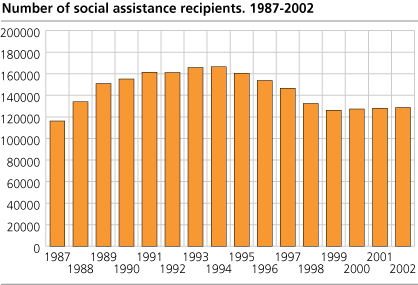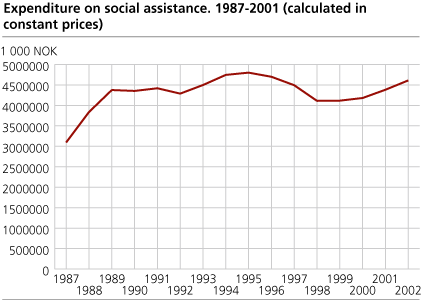Content
Published:
This is an archived release.
Number of social assistance recipients stabilized
The number of social assistance recipients has been stabilized for the last three years, after an increase from 1999 to 2000. Almost half of the 128 800 recipients only received social assistance for three months or less last year. Only two out of ten received social assistance for ten months or more. This is a small increase compared to the year before.
In addition to those who are listed as recipients of social assistance, many of them have children and a spouse. If we take this in to account, there were approximately 209 700 people who received social assistance for a shorter or longer time in 2002, i.e. five per cent of the population received social assistance. The number is higher than the year before, but there is an increase relative to the year 2000. The equivalent number in 2000 was four per cent of the population.
NOK 4.6 billion in social assistance was paid out last year, an increase of about NOK 228 million, or 4,9 percent compared with 2001 (calculated in constant prices). The average annual social assistance benefit per recipient last year was NOK 35.800, or almost NOK 7.000 per month white assistance. The average benefit time for all recipients was five months last year- approximately the same level as in 2001.
Few changes in the age mix
For several years the number of recipients has been highest in the age cohort 20 to 29 years. In 2002 this group represented 31 percent of the social assistance recipients. Almost seven per cent of this group is registered as social assistance recipients. Even though this is the biggest group among social assistance recipients, it is in the two age cohorts 30-39 and 40-49 we found the highest average payments, which was approximately NOK 40 000.
Finnmark has the highest share
There are considerable differences among the counties in the number of social assistance cases in proportion to the population. Since 1998 Finnmark has had the highest proportion of such cases. Until 1998 Oslo was the county with the highest number of social assistance cases per 1.000 inhabitants, but in 1998 Finnmark got the highest portion with 47 cases per 1.000 inhabitants, while Oslo had 44. Since 1998 both counties have had a steady decrease, and today the two counties have 43 and 38 cases respectively per 1.000 inhabitants.
Akershus and Sogn og Fjordane were in the same period the counties with fewest social assistance cases in proportion to the population, with 22 cases per 1.000 inhabitants in 1998, compared with 21 and 25 cases respectively in 2001. In 2001 Møre og Romsdal also had 25 cases per 1.000 inhabitants. In 2002 Akershus still is the county with fewest social assistance cases in proportion to the population, with 21 cases per 1.000 inhabitants. Sogn og Fjordane has 26 cases pr 1.000 inhabitants, while Møre og Romsdal has 25 cases per 1.000 inhabitants.
The percentage of social assistance cases increases with the number of inhabitants in the municipality. Municipalities with more than 50.000 inhabitants have an average of 34 cases per 1.000 inhabitants, while the corresponding number for municipalities with below 5.000 residents is 27.
Tables:
- Table 1 Number of cases on social assistance, by age, county and size of municipality. 1987-2002
- Table 2 Expenditure on social assistance, by nature of assistance, county and size of municipality. 1987-2002. 2002-NOK
- Table 3 Average payments of social assistance per month on assistance. Figures of duration of benefit and family cycle phase. 2002
- Table 4 Recipients of social assistance, by duration of benefit and family cycle phase. 2002
- Table 5 Recipients of social assistance, by number of municipalities from which they have received payments and age. 2002
- Table 6 Recipients of social assistance, by main source of income and family cycle phase. 2002
- Table 7 Recipients of social assistance, by labour force status and family cycle phase. 2002
- Table 8 Recipients of social assistance, by type of allowance and family cycle phase. 2002
- Table 9 Recipients of social assistance, by citizenship and age. 2002
- Table 10 Number of cases on social assistance, by age and municipality. 2002
- Table 11 Expenditure on social assistance, by nature of assistance and municipality. 2002. 2002-NOK
Contact
-
Unni Beate Grebstad
E-mail: unni.grebstad@ssb.no
tel.: (+47) 94 50 68 66


